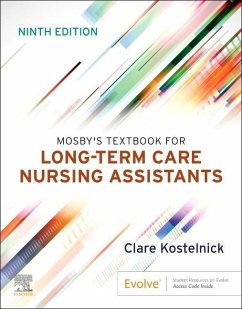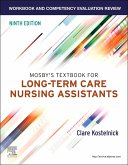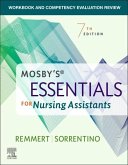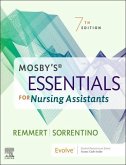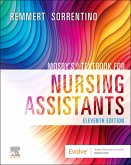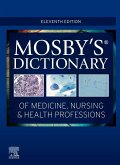Clare Kostelnick (Professor Emeritus and Nurse Assistant Instructor
Mosby's Textbook for Long-Term Care Nursing Assistants
Clare Kostelnick (Professor Emeritus and Nurse Assistant Instructor
Mosby's Textbook for Long-Term Care Nursing Assistants
- Broschiertes Buch
- Merkliste
- Auf die Merkliste
- Bewerten Bewerten
- Teilen
- Produkt teilen
- Produkterinnerung
- Produkterinnerung
A comprehensive guide to the role and responsibilities of the nursing assistant, this book prepares you to succeed as a professional caregiver for residents in long-term care settings. Not only does the book cover the functions and limitations of the nursing assistant's role, but its delegation guidelines outline the information you need to collect from the nurse and care plan before performing and then documenting a procedure. This text also helps you prepare for success on the Nursing Assistant certification exam.--back cover.
Andere Kunden interessierten sich auch für
![Workbook and Competency Evaluation Review for Mosby's Textbook for Long-Term Care Nursing Assistants Workbook and Competency Evaluation Review for Mosby's Textbook for Long-Term Care Nursing Assistants]() Clare Kostelnick (Professor Emeritus and Nurse Assistant InstructorWorkbook and Competency Evaluation Review for Mosby's Textbook for Long-Term Care Nursing Assistants35,99 €
Clare Kostelnick (Professor Emeritus and Nurse Assistant InstructorWorkbook and Competency Evaluation Review for Mosby's Textbook for Long-Term Care Nursing Assistants35,99 €![Workbook and Competency Evaluation Review for Mosby's Essentials for Nursing Assistants Workbook and Competency Evaluation Review for Mosby's Essentials for Nursing Assistants]() Leighann Remmert (Williamsv Certified Nursing Assistant InstructorWorkbook and Competency Evaluation Review for Mosby's Essentials for Nursing Assistants40,99 €
Leighann Remmert (Williamsv Certified Nursing Assistant InstructorWorkbook and Competency Evaluation Review for Mosby's Essentials for Nursing Assistants40,99 €![Mosby's Textbook for Medication Assistants Mosby's Textbook for Medication Assistants]() Karen AndersonMosby's Textbook for Medication Assistants88,99 €
Karen AndersonMosby's Textbook for Medication Assistants88,99 €![Mosby's Essentials for Nursing Assistants Mosby's Essentials for Nursing Assistants]() Leighann Remmert (Williamsv Certified Nursing Assistant InstructorMosby's Essentials for Nursing Assistants75,99 €
Leighann Remmert (Williamsv Certified Nursing Assistant InstructorMosby's Essentials for Nursing Assistants75,99 €![Workbook and Competency Evaluation Review for Mosby's Textbook for Nursing Assistants Workbook and Competency Evaluation Review for Mosby's Textbook for Nursing Assistants]() Leighann Remmert (Williamsv Certified Nursing Assistant InstructorWorkbook and Competency Evaluation Review for Mosby's Textbook for Nursing Assistants42,99 €
Leighann Remmert (Williamsv Certified Nursing Assistant InstructorWorkbook and Competency Evaluation Review for Mosby's Textbook for Nursing Assistants42,99 €![Mosby's Textbook for Nursing Assistants Mosby's Textbook for Nursing Assistants]() Leighann Remmert (Williamsv Certified Nursing Assistant InstructorMosby's Textbook for Nursing Assistants83,99 €
Leighann Remmert (Williamsv Certified Nursing Assistant InstructorMosby's Textbook for Nursing Assistants83,99 €![Mosby's Dictionary of Medicine, Nursing & Health Professions Mosby's Dictionary of Medicine, Nursing & Health Professions]() MosbyMosby's Dictionary of Medicine, Nursing & Health Professions57,99 €
MosbyMosby's Dictionary of Medicine, Nursing & Health Professions57,99 €-
-
-
A comprehensive guide to the role and responsibilities of the nursing assistant, this book prepares you to succeed as a professional caregiver for residents in long-term care settings. Not only does the book cover the functions and limitations of the nursing assistant's role, but its delegation guidelines outline the information you need to collect from the nurse and care plan before performing and then documenting a procedure. This text also helps you prepare for success on the Nursing Assistant certification exam.--back cover.
Produktdetails
- Produktdetails
- Verlag: Elsevier - Health Sciences Division
- 9 ed
- Seitenzahl: 704
- Erscheinungstermin: 6. September 2023
- Englisch
- Abmessung: 217mm x 277mm x 29mm
- Gewicht: 1482g
- ISBN-13: 9780323874885
- ISBN-10: 0323874886
- Artikelnr.: 67824653
- Herstellerkennzeichnung
- Libri GmbH
- Europaallee 1
- 36244 Bad Hersfeld
- gpsr@libri.de
- Verlag: Elsevier - Health Sciences Division
- 9 ed
- Seitenzahl: 704
- Erscheinungstermin: 6. September 2023
- Englisch
- Abmessung: 217mm x 277mm x 29mm
- Gewicht: 1482g
- ISBN-13: 9780323874885
- ISBN-10: 0323874886
- Artikelnr.: 67824653
- Herstellerkennzeichnung
- Libri GmbH
- Europaallee 1
- 36244 Bad Hersfeld
- gpsr@libri.de
Clare Kostelnick is professor emeritus at Des Moines Area Community College where she continues to teach nursing assistant courses. She received her BSN from the Brokaw School of Nursing of Illinois Wesleyan University. She began her career as a registered nurse serving in the US Army Nurse Corps. Having achieved the rank of captain, she spent most of her military career working in emergency care. Clare's 45 years of nursing experience also includes working in critical care as a staff nurse, a home care and hospice staff nurse, a long-term care staff nurse and consultant, and a coordinator of an assisted living facility. She has taught nursing assistant classes for over 20 years. Clare is a cardiopulmonary resuscitation (CPR) instructor for the American Heart Association and is a member of the Iowa Health Educators Association.
1. The Nursing Assistant Working in Long-Term Care
2. Resident Rights, Ethics, and Laws
3. Work Ethics
4. Communicating with the Health Team
5. Assisting with the Nursing Process
6. Understanding the Resident
7. Culture and Religion
8. Body Structure and Function
9. The Older Person
10. Sexuality
11. Safety
12. Preventing Falls
13. Restraint Alternatives and Safe Restraint Use
14. Preventing Infection
15. Body Mechanics and Safe Resident Handling, Moving, and Transfers
16. The Resident's Unit
17. Bedmaking
18. Hygiene
19. Grooming
20. Nutrition and Fluids
21. Nutritional Support and IV Therapy
22. Urinary Elimination
23. Bowel Elimination
24. Exercise and Activity
25. Comfort, Rest, and Sleep
26. Oxygen Needs and Respiratory Therapies
27. Measuring Vital Signs
28. Assisting With the Physical Examination
29. Collecting and Testing Specimens
30. Admissions, Transfers, and Discharges
31. Wound Care
32. Pressure Injuries
33. Hearing, Speech, and Vision Problems
34. Cancer, Immune System, and Skin Disorders
35. Nervous System and Musculoskeletal Disorders
36. Cardiovascular and Respiratory System Disorders
37. Digestive and Endocrine System Disorders
38. Urinary and Reproductive System Disorders
39. Mental Health Problems
40. Confusion and Dementia
41. Developmental Disabilities
42. Rehabilitation and Restorative Nursing Care
43. Assisted Living
44. Basic Emergency Care
45. End-of-Life Care
46. Getting a Job - Career Management
Review Question Answers
Appendixes
Glossary
Key Abbreviations
Index
2. Resident Rights, Ethics, and Laws
3. Work Ethics
4. Communicating with the Health Team
5. Assisting with the Nursing Process
6. Understanding the Resident
7. Culture and Religion
8. Body Structure and Function
9. The Older Person
10. Sexuality
11. Safety
12. Preventing Falls
13. Restraint Alternatives and Safe Restraint Use
14. Preventing Infection
15. Body Mechanics and Safe Resident Handling, Moving, and Transfers
16. The Resident's Unit
17. Bedmaking
18. Hygiene
19. Grooming
20. Nutrition and Fluids
21. Nutritional Support and IV Therapy
22. Urinary Elimination
23. Bowel Elimination
24. Exercise and Activity
25. Comfort, Rest, and Sleep
26. Oxygen Needs and Respiratory Therapies
27. Measuring Vital Signs
28. Assisting With the Physical Examination
29. Collecting and Testing Specimens
30. Admissions, Transfers, and Discharges
31. Wound Care
32. Pressure Injuries
33. Hearing, Speech, and Vision Problems
34. Cancer, Immune System, and Skin Disorders
35. Nervous System and Musculoskeletal Disorders
36. Cardiovascular and Respiratory System Disorders
37. Digestive and Endocrine System Disorders
38. Urinary and Reproductive System Disorders
39. Mental Health Problems
40. Confusion and Dementia
41. Developmental Disabilities
42. Rehabilitation and Restorative Nursing Care
43. Assisted Living
44. Basic Emergency Care
45. End-of-Life Care
46. Getting a Job - Career Management
Review Question Answers
Appendixes
Glossary
Key Abbreviations
Index
1. The Nursing Assistant Working in Long-Term Care
2. Resident Rights, Ethics, and Laws
3. Work Ethics
4. Communicating with the Health Team
5. Assisting with the Nursing Process
6. Understanding the Resident
7. Culture and Religion
8. Body Structure and Function
9. The Older Person
10. Sexuality
11. Safety
12. Preventing Falls
13. Restraint Alternatives and Safe Restraint Use
14. Preventing Infection
15. Body Mechanics and Safe Resident Handling, Moving, and Transfers
16. The Resident's Unit
17. Bedmaking
18. Hygiene
19. Grooming
20. Nutrition and Fluids
21. Nutritional Support and IV Therapy
22. Urinary Elimination
23. Bowel Elimination
24. Exercise and Activity
25. Comfort, Rest, and Sleep
26. Oxygen Needs and Respiratory Therapies
27. Measuring Vital Signs
28. Assisting With the Physical Examination
29. Collecting and Testing Specimens
30. Admissions, Transfers, and Discharges
31. Wound Care
32. Pressure Injuries
33. Hearing, Speech, and Vision Problems
34. Cancer, Immune System, and Skin Disorders
35. Nervous System and Musculoskeletal Disorders
36. Cardiovascular and Respiratory System Disorders
37. Digestive and Endocrine System Disorders
38. Urinary and Reproductive System Disorders
39. Mental Health Problems
40. Confusion and Dementia
41. Developmental Disabilities
42. Rehabilitation and Restorative Nursing Care
43. Assisted Living
44. Basic Emergency Care
45. End-of-Life Care
46. Getting a Job - Career Management
Review Question Answers
Appendixes
Glossary
Key Abbreviations
Index
2. Resident Rights, Ethics, and Laws
3. Work Ethics
4. Communicating with the Health Team
5. Assisting with the Nursing Process
6. Understanding the Resident
7. Culture and Religion
8. Body Structure and Function
9. The Older Person
10. Sexuality
11. Safety
12. Preventing Falls
13. Restraint Alternatives and Safe Restraint Use
14. Preventing Infection
15. Body Mechanics and Safe Resident Handling, Moving, and Transfers
16. The Resident's Unit
17. Bedmaking
18. Hygiene
19. Grooming
20. Nutrition and Fluids
21. Nutritional Support and IV Therapy
22. Urinary Elimination
23. Bowel Elimination
24. Exercise and Activity
25. Comfort, Rest, and Sleep
26. Oxygen Needs and Respiratory Therapies
27. Measuring Vital Signs
28. Assisting With the Physical Examination
29. Collecting and Testing Specimens
30. Admissions, Transfers, and Discharges
31. Wound Care
32. Pressure Injuries
33. Hearing, Speech, and Vision Problems
34. Cancer, Immune System, and Skin Disorders
35. Nervous System and Musculoskeletal Disorders
36. Cardiovascular and Respiratory System Disorders
37. Digestive and Endocrine System Disorders
38. Urinary and Reproductive System Disorders
39. Mental Health Problems
40. Confusion and Dementia
41. Developmental Disabilities
42. Rehabilitation and Restorative Nursing Care
43. Assisted Living
44. Basic Emergency Care
45. End-of-Life Care
46. Getting a Job - Career Management
Review Question Answers
Appendixes
Glossary
Key Abbreviations
Index

